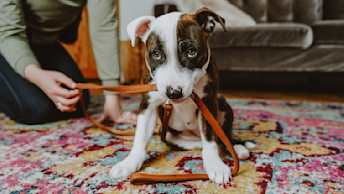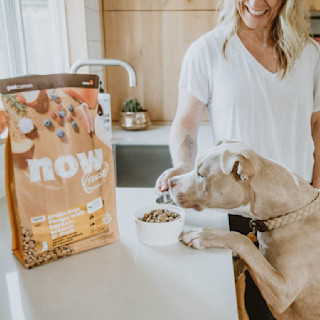April 8, 2024
How to Leash Train a Dog That Won’t Walk on a Leash

For most dogs, going for a walk is the highlight of their day. They can’t wait to get out and explore the world beyond their backyard. That’s why it can be so bewildering when you come across a dog that won’t walk on a leash, and when it’s time for a walk refuses to do anything more than lay on the ground like a pancake.
It’s tempting to jerk the dog’s leash or tug on it to get him to move, but this does more harm than it does good.
Not only does it encourage your dog to resist the pressure and dig in with even more determination, but it can also cause permanent damage to the muscles and nerves within the neck, not to mention the thyroid gland and trachea.
Positive reinforcement training is the most effective way to leash train a dog that won’t walk but, before jumping into how to train a dog to walk on a leash, we first need to understand what’s causing the dog to behave in this way.
Three Reasons a Dog Might Refuse to Walk
1. Pain
Dogs with an underlying health problem may find exercise uncomfortable or even painful. To make sure this isn’t the case, check your dog thoroughly, looking for any signs of injury. Inspect his paws, making sure no sharp objects are causing him pain. Examine his collar, ensuring it is correctly fitted and not rubbing or constricting him in any way.
If your dog is limping or shows any signs of discomfort when getting up or moving around, you’ll need to see a vet. Dogs often disguise their pain and may be suffering from a serious health issue, such as arthritis or canine hip dysplasia.
Don’t force your dog to go out for a walk until you’ve ruled out the possibility of any health conditions. Making him walk when he’s in pain will only exacerbate the situation.
Other health problems, such as those that affect a dog’s ability to see and hear, could also impact his willingness to go for a walk and his ability to enjoy the experience.
2. Anxiety
Some dogs are more anxious and fearful than others. For those sensitive canines, the idea of going out for a walk can be overwhelming. The noises, smells, and sounds are just too much for him to process. The noise of a garbage truck rattling up the street or the sudden appearance of a stranger around the corner can be all it takes to stop an anxious dog in its tracks.
If your dog is struggling with stress and anxiety, this reactivity online class can help you overcome it.
3. Lack of Training
It isn’t natural for a dog to wear a collar and leash, which is why many puppies resist it the first time around. Puppies also lack the confidence of older dogs and naturally want to stay close to home, where they feel safe and protected.

Positive reinforcement training can help you build your puppy’s confidence, deepen your bond with one another, and encourage him to trust you in new situations. One easy way to try this is by rewarding your dog along the way with his favourite treats or kibble.

Our Recommendation
Now Fresh Puppy Food
Our grain-free puppy food is carefully crafted with fresh meat and nutrient-dense fruits and veggies to support healthy development.
View puppy foodEasy Exercises to Get Your Dog Moving
A dog that’s nervous about venturing outside or feels uncomfortable walking on a leash needs to be given the opportunity to get used to whatever’s scaring him in a safe environment.
If your dog shies away from the collar and leash, it’s probably a fear of the equipment that’s preventing him from walking. Getting him comfortable with the collar and leash at home will, therefore, help resolve the problem.
Familiarize Your Dog with His Collar and Leash
- Start by laying his collar and leash on the ground and letting him sniff and familiarize himself with this strange new equipment.
- Next, place the collar loosely around the dog’s neck but don’t fasten it. If he stands still, let the collar fall to the ground, and reward him with a treat.
- Once you’ve repeated this exercise a few times, you can fasten the collar and let your dog wander around the house, getting used to how wearing a collar feels.
- Once he appears comfortable with the collar, clip on the leash and hold it loosely in your hand. As long as your dog isn’t pulling away from you or lying flat on the floor, give him a treat before removing both the collar and leash.
- Repeat this exercise several times a day until your dog’s completely comfortable with having the collar and leash put on.
You’re then ready to get your dog to take a few steps towards you while wearing the collar and leash.
Encourage Your Dog to Take the Next Step
- Always use encouragement. To do this, move to the end of the leash and kneel facing your dog. Have a few treats or your dog’s favorite toy to encourage him to move towards you.
- While kneeling, call to your dog and encourage him to come towards you.
- As soon as he makes a move in the right direction, reward him with a treat or a quick game with his favorite toy.
- Move back to the end of the leash again and repeat.
- Once your dog is moving towards you easily, mix things up a little by kneeling to the side rather than directly in front of him.
- If he becomes confused or refuses to move, repeat the first step before trying again.
- Now stand in front of your dog and repeat the exercise, moving a few steps further away each time.
This exercise teaches your dog that there’s a treat available every time he moves forward and encourages him to focus on you rather than what’s going on around him.
Once you’ve mastered this exercise inside the house, you can take it outside, encouraging your dog to follow you around the garden and interact with different objects.

Use treats to reward your dog each time he moves forward and gradually increase how far you travel from the house. Now, clip his leash onto the collar and repeat the exercise. Don’t pull on the leash to attract his attention - simply carry on encouraging and rewarding him as you did previously.
Once your dog is relaxed and walking with you, you can start increasing the distance and duration of your explorations. Start with a brief walk to the gate and then progress to the nearest street corner or lamppost.
Help Your Dog Overcome Anxiety
A dog that’s comfortable with the collar and leash but still refuses to walk is probably frightened or anxious.
Maybe you find your dog walks happily until the garbage truck trundles past, at which point she lies on the ground and refuses to move. This behaviour suggests a fear of loud noises is responsible for her reluctance to walk. To get around this problem, you can try changing her routine so that you only walk her after the truck’s done its rounds.
Similarly, if there’s a specific object your dog refuses to walk past, you can try sprinkling a trail of treats on the path alongside and beyond the object.
Get your dog to sit and reward him before pointing him in the right direction. This will get him to focus on you - and the treats - and forget about the scary monster disguising itself as a rock.
Conclusion
Understanding your dog’s behaviour is key to changing that behaviour into something more positive. Understandably, a dog that’s experiencing pain will bark at anything that exacerbates that pain, so it’s important to tackle any underlying health considerations before trying to leash train a dog that doesn’t want to walk.

If you’re sure your dog is in good health, use positive reinforcement techniques to encourage him to accept the collar and leash and overcome the fears that prevent him from enjoying his walk.



